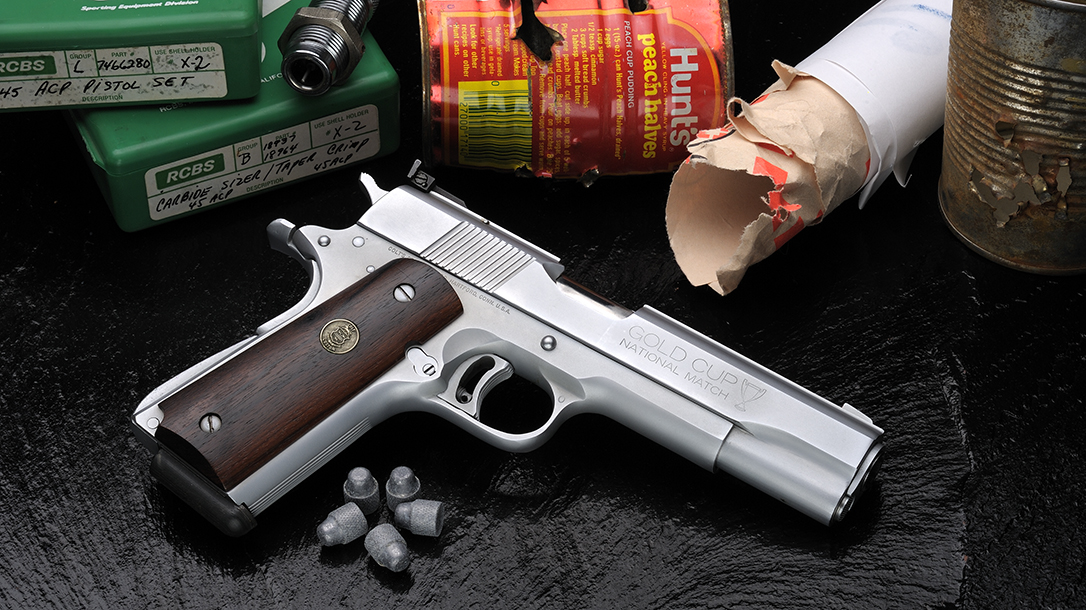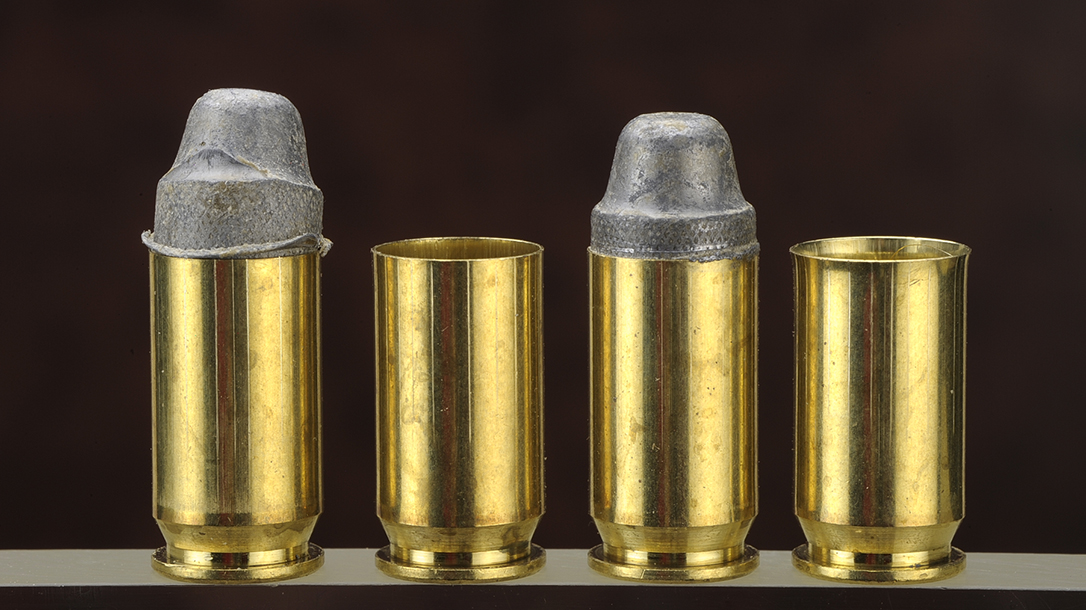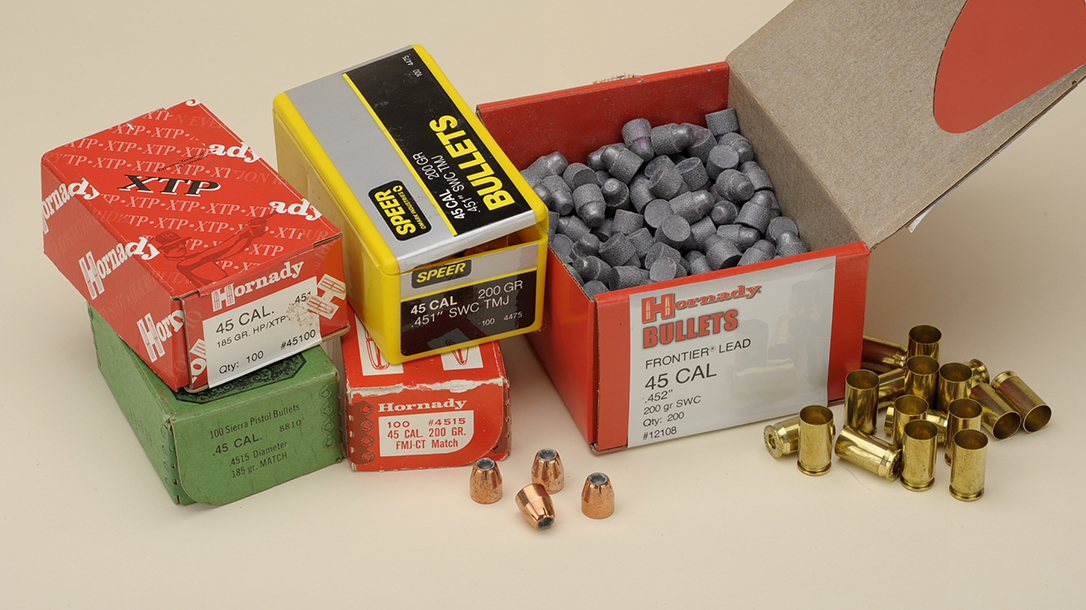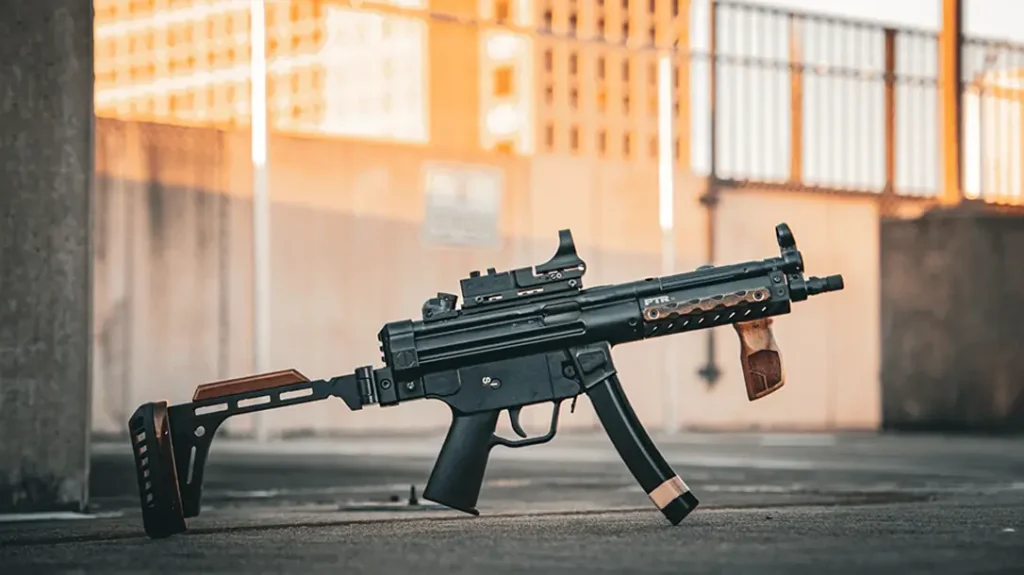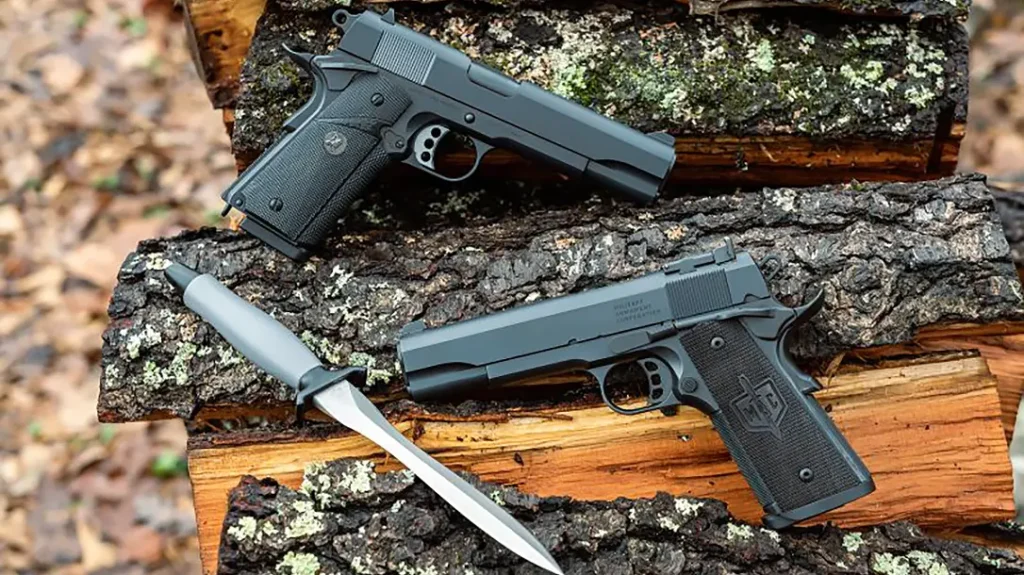Target loads are like vacations. When you get tired of shooting full-house ammunition in your 1911, you can load .45 ACP ammo, slow down and enjoy shooting at a leisurely pace. You’ll feel no stress, no pain—just a good time at the range or out in the field plinking. In addition, you can hone your accuracy while also sighting in your gun at closer, more comfortable distances and saving money over the cost of factory loads.
Handloading .45 ACP Ammo
Having the ability to custom-blend a specific handload for your favorite gun is a great advantage. When you make ammo with velocities in the 700-fps range, there’s less fatigue on the barrel and shooter, even with lighter jacketed bullets, and you’ll have more powder left over. You can also save money by casting your own bullets, which many more formal Bullseye shooters do with aplomb. My opinion? If I choose to use lead bullets for practice, I still find factory swaged bullets more uniform in weight and overall consistency than most homemade bullets. But the choice is yours.
Advertisement — Continue Reading Below
I’ve field tested just about every .45-caliber handgun over the years. And even though most of them today are set up for “hardball” ammunition, out the box they might be a little balky with milder loads. You can add a lighter spring or up the ante on powder to compensate for the newness until the gun breaks in. My personal target gun is a Colt Gold Cup that I have owned since November of 1977. I have used that gun in IPSC matches over the years, and it has never failed me. It was blued when I originally bought it, but because of holster wear, I later had it glass-beaded and hard-chromed, which turned out to be much easier to maintain.
Digging In
I have narrowed down a couple of bullet choices for my .45 target loads. On the jacketed side, I go with 185-grain bullets. They make the job easier when it comes to the wide range of products out there, and over the long haul, they seem to have an accuracy advantage over their lead counterparts. Target-designed bullets come in a variety of shapes and sizes, but for the most part, stick with those marked “semi-wadcutter target,” as illustrated within the pages of loading manuals. With jacketed bullets, there is no messing around with casting and swaging bullets. If you shoot a lot and buy in quantity, prices drop substantially. These lighter bullets, combined with smaller powder charges, tend to make the recoil sensation tolerable for longer sessions.
When it comes to lead bullets, I use Hornady 200-grain semi-wadcutters. These are great bullets for short-range work—around 20 to 25 yards—as the bullet holes show up clean and clear, even without a spotting scope. They are mild to shoot with a majority of powders, and will deliver the goods much better than I can from a Ransom Rest. If I run out of the Hornady brand, I turn to Speer and its 200-grain lead semi-wadcutter bullets, with equal results. I see no advantage to a heavier 230-grain bullet for target use.
Advertisement — Continue Reading Below
Plentiful Powders
Looking at the manuals, you’ll numerous powders to choose from. However, over the years I’ve narrowed it down to Bullseye, Unique, Herco and Winchester 231. These powders will give me 1-inch groups at 50 feet when my gun is mounted in a machine rest. It’s fun to fine-tune your target loads, and looking back at my records, as little as half a grain could make a marked difference in your groups. Keep in mind that since the powder charges are different between lead and jacketed bullets, it’s always wise to check each case before seating any bullet. Double charges aren’t the best way recipe for a day of good shooting.
Initially, new .45 ACP ammo cases are the way to go regardless of the bullet used. With this caliber, the cases have long lifetimes with reduced-power loads and standard primers; you are on your way to a perfect combination for your handgun. Regardless of whether the cases are new or not, it is always a good idea to size them for uniformity. With lead bullets, the flare, or belling, of the case can be opened a little more to prevent shaving of the bullet upon entry.
Since the .45 ACP headspaces on the case mouth, the last thing you need is a buildup of lead or lube at this point, which could prevent the slide from closing. Using jacketed bullets, less belling is involved. Just be sure the bullet is sitting squarely on top of the case before seating. After seating either type of bullet to the overall length in the manual, finish up with a moderate taper crimp.
Advertisement — Continue Reading Below
Testing Time: .45 ACP Ammo
The best part of this whole thing is testing at the range. Pick out a nice day to make it all enjoyable, have everything in order with reference to bullets and powder charges, and get to it! Before I head to the range, however, I make sure to pack small coin envelopes (3 by 6 inches) that are just large enough for five to 10 rounds of pistol ammunition. Carefully marked on each envelope are the bullet, powder charge and primer. A notebook follows all this to the range.
The whole purpose of the range session is to zero in on the best load for your own 1911. Don’t be disappointed if some of the loads go wider than expected; there will be loads that offer a great deal of promise and involve some extra work later. The best thing is to purchase either a Ransom Rest or one of the more inexpensive pistol rests now on the market. Before embarking on a testing session, I take either type of rest and bolt it down on a straight piece of 1×6 or 1×8 wood.
My range has shooting stations on the pistol end that measure around 30 inches wide. Cut the wood to this length, place it on the station and C-clamp the rest to it. When shooting, make sure the frame of the gun—and not the forward part of the slide—is sitting on the rest. Squeeze the trigger deliberately for each shot. Keep in mind that you are testing the gun and your handloads, not yourself.
Advertisement — Continue Reading Below
Keep It Simple
To keep things simple, start with one brand of powder; you might want to try loading Speer’s 185-grain match semi-wadcutters ahead of 4.5 grains of Bullseye and seated to 1.24 inches. Using 4.4 grains of the same powder and a lead, 200-grain semi-wadcutter from Hornady, I was able to achieve 1-inch groups with the bullet seated to 1.2 inches.
For a change of pace, working up target loads for any gun used for competition or small-game hunting can be addictive. There is a certain calming effect to be had here, and also the satisfaction of knowing that when you go out with your 1911, you have the best loads possible.
Advertisement — Continue Reading Below
This article is from the September-October 2019 issue of Combat Handguns magazine. Grab your copy at OutdoorGroupStore.com. For digital editions, visit Amazon.
